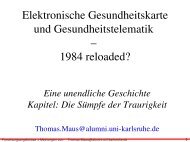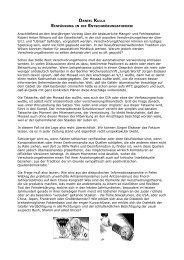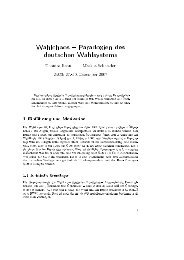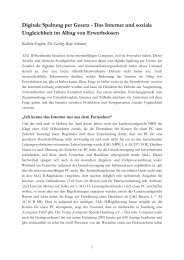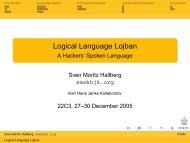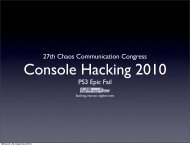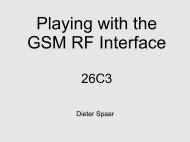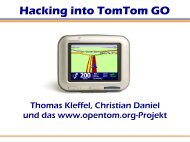Complete Hard Disk Encryption Using FreeBSD's GEOM Framework
Complete Hard Disk Encryption Using FreeBSD's GEOM Framework
Complete Hard Disk Encryption Using FreeBSD's GEOM Framework
Create successful ePaper yourself
Turn your PDF publications into a flip-book with our unique Google optimized e-Paper software.
The leakage risk is also another reason why filebased encryption is virtually useless.<br />
While this issue is certainly a problem for sensitive data, there is a far bigger problem,<br />
which so far has been quietly ignored.<br />
2.4 New attack vectors<br />
The point of storing data is to be able to retrieve it at some later date. So far, everything<br />
that was discussed, was based on the assumption that both the OS and the applications<br />
were stored unencrypted – there is also no point in doing otherwise as long as the data<br />
itself is not encrypted:<br />
• if data cannot 4 be destroyed, stolen or modified remotely, a dedicated attacker<br />
will find a way to gain local (physical) access to the system<br />
• if login procedures, filesystem access control and other restrictions imposed by<br />
the OS and applications cannot be defeated or circumvented, the attacker will<br />
boot his/her own OS<br />
• if the booting sequence on the machine is protected, the attacker will remove<br />
the hard disk and access it from a system under his control<br />
• if the data on the hard disk is encrypted and a bruteforce attack is not feasible,<br />
then the attacker will most likely 5 target the OS and/or the applications<br />
The key motivation behind complete disk encryption is illustrated in the last point: the<br />
OS and the applications are now the target. Instead of breaking the encryption, an<br />
attacker can try and subvert the kernel or the applications, so they leak the desired data<br />
or the encryption key.<br />
The goal is therefore to encrypt the OS and all the applications as well. Just as any<br />
security measure that is taken, this scheme involves tradeoffs, such as less convenience<br />
and decreased performance. These issues will be discussed later. Every user considering<br />
this scheme must therefore decide for him or herself, whether the increase in security is<br />
worth the tradeoffs.<br />
3 <strong>Complete</strong> disk encryption<br />
3.1 Tools provided by FreeBSD<br />
The platform of choice here is FreeBSD, because it comes with a modular, very powerful<br />
I/O framework called <strong>GEOM</strong> [Kamp, 2003b] since the release of the 5.x branch. The 5.x<br />
branch underwent several major changes compared to the 4.x branch and was not<br />
declared STABLE until the 5.3RELEASE in November 2004. The 5.x branch did,<br />
however, feature a <strong>GEOM</strong> class and a corresponding userland utility called GBDE<br />
(<strong>GEOM</strong> Based <strong>Disk</strong> <strong>Encryption</strong>) as early as January 2003 when 5.0RELEASE came out.<br />
GBDE was specifically designed to operate on the sector level and is therefore able to<br />
4 perfect security is not possible; therefore 'cannot' should rather be read as 'cannot easily enough'<br />
5 tampering with the hardware is of course also possible, for example with a hardware keylogger;<br />
defending against this kind of attack is not discussed in this paper<br />
6



